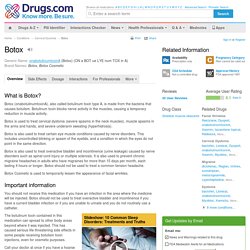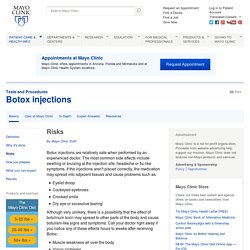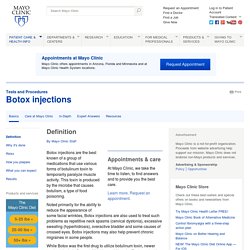

Question. Botox Injections: Uses, Side Effects & Warnings. Generic Name: onabotulinumtoxinA (Botox) (ON a BOT ue LYE num TOX in A)Brand Names: Botox, Botox Cosmetic What is Botox?

Botox (onabotulinumtoxinA), also called botulinum toxin type A, is made from the bacteria that causes botulism. Botulinum toxin blocks nerve activity in the muscles, causing a temporary reduction in muscle activity. Botox is used to treat cervical dystonia (severe spasms in the neck muscles), muscle spasms in the arms and hands, and severe underarm sweating (hyperhidrosis). Botox is also used to treat certain eye muscle conditions caused by nerve disorders. Botox is also used to treat overactive bladder and incontinence (urine leakage) caused by nerve disorders such as spinal cord injury or multiple sclerosis. Botox Cosmetic is used to temporarily lessen the appearance of facial wrinkles. Important information You should not receive this medication if you have an infection in the area where the medicine will be injected.
Question. BOTOX® (OnabotulinumtoxinA) Injection and BOTOX® Cosmetic - Treatment Information. Botox injections Risks - Tests and Procedures. Botox injections are relatively safe when performed by an experienced doctor.

The most common side effects include swelling or bruising at the injection site, headache or flu-like symptoms. If the injections aren't placed correctly, the medication may spread into adjacent tissues and cause problems such as: Eyelid droop Cockeyed eyebrows Crooked smile Dry eye or excessive tearing Although very unlikely, there is a possibility that the effect of botulinum toxin may spread to other parts of the body and cause botulism-like signs and symptoms. Call your doctor right away if you notice any of these effects hours to weeks after receiving Botox: Muscle weakness all over the body Vision problems Trouble speaking or swallowing Trouble breathing Loss of bladder control Doctors generally recommend against using Botox when you're pregnant or breast-feeding, since the effects on the baby aren't known.
Select your doctor carefully Botox must be used only under a doctor's care. Feb. 06, 2013 References. BOTOX® Treatment for Hyperhidrosis and Excessive Underarm Perspiration. BOTOX Costs, Prices & Financing. Updated The average BOTOX® treatment price ranges from $350 to $500 for each area injected.

BOTOX® injection cost can vary greatly according to geographic region and depending on the doctor who performs the procedure. For those on a budget, convenient BOTOX® financing plans can make treatment easily affordable. BOTOX® Cosmetic – Average Cost In 2005, the national average cost of a BOTOX® injection was just over $375. The cost of your BOTOX® injections will depend on other factors as well. BOTOX® Injection Cost Breakdown Most practices have a flat cost for each injection of BOTOX® Cosmetic, though some will break it down by “units” used per treatment. RELATED: Find a qualified cosmetic dermatologist in your area What You Should Know about BOTOX® Price Discounts BOTOX ® Cosmetic price variables should be weighed against other factors such as the quality of the cosmetic surgery practice and the professional qualifications of the doctor.
Botox injections Definition - Tests and Procedures. Botox injections are the best known of a group of medications that use various forms of botulinum toxin to temporarily paralyze muscle activity.

This toxin is produced by the microbe that causes botulism, a type of food poisoning. Noted primarily for the ability to reduce the appearance of some facial wrinkles, Botox injections are also used to treat such problems as repetitive neck spasms (cervical dystonia), excessive sweating (hyperhidrosis), overactive bladder and some causes of crossed eyes. Botox injections may also help prevent chronic migraines in some people. While Botox was the first drug to utilize botulinum toxin, newer products include Dysport, Myobloc and Xeomin. Each product is a little different, particularly when it comes to dosage units, so they aren't interchangeable. Why it's doneFeb. 06, 2013 References Carruthers J, et al. Botox: Read About Risks and Side Effects. Botox Injections Botox Injections Overview Botulinum toxin (Botox, onabotulinumtoxinA) is a material that has been known for over a century and used for medical purposes for more than 50 years.

Its initial uses were for lazy eye (strabismus), blepharospasm (inability to move the eyelids in certain ways), and wry neck (cervical dystonia). In 2002, it was approved for improving and relaxing frown lines in the area (the glabella) between the eyes on the forehead and has been used successfully in more than over 11 million patients since that time, based on estimates from data supplied by the Allergan Corporation. In 2004, Botox was approved for excess sweating (hyperhidrosis), and in 2010, Botox was approved for the treatment of migraines. A common misconception is that Botox actually paralyzes the muscles in the face. Medically Reviewed by a Doctor on 12/12/2014. Botulinum toxin. Botulinum toxin is a protein and neurotoxin produced by the bacterium Clostridium botulinum.[1][2] It is the most acutely lethal toxin known, with an estimated human median lethal dose (LD-50) of 1.3–2.1 ng/kg intravenously or intramuscularly and 10–13 ng/kg when inhaled.[3] Botulinum toxin (BTX) can cause botulism, a serious and life-threatening illness in humans and animals.

Three forms of botulinum toxin type A (Botox, Dysport and Xeomin) and one form of botulinum toxin type B (MyoBloc) are available commercially for various cosmetic and medical procedures. Biochemistry and mechanism of toxicity[edit] Target molecules of botulinum (BoNT) and tetanus (TeNT) toxins inside the axon terminal.[4] History[edit] Justinus Kerner described botulinum toxin as a "sausage poison" and "fatty poison",[7] because the bacterium that produces the toxin often caused poisoning by growing in improperly handled or prepared meat products. Therapeutic research[edit]